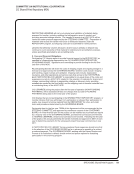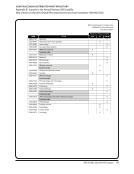SPEC Kit 345: Shared Print Programs · 35
Our joint catalog has led to much increased borrowing and lending and has greatly increased faculty and
student satisfaction.
Our shared print program is part of an established consortium, so our relationships within that consortium are already
good and facilitate collaboration.
Our staff have connected with additional functional peers.
Participating in worthy programs. Reduced need for shelving space. Defer preservation activities.
Participation in the GWLA project contributes knowledge and experience for prospective projects in our regional
Colorado Alliance project, and with sister campuses on retaining joint physical collections that do not duplicate national
efforts extensively.
Preservation of selected titles of regional interest and a specialized group of journals collected as part of an
exchange program.
Provided opportunities for library staff to work together towards a common goal that has national importance.
Provides an opportunity to learn about issues related to space and long-term storage and access to print journals that
are faced at other institutions.
Shared print is an outgrowth of other relationships, such as resource sharing.
Shared print program is actually built on existing collaboration rather than vice versa. Sharing print collections will
facilitate existing efforts to collaborate on collection development.
Sooner or later, we will feel dependent on strong coordination of shared print programs to avoid/delay the filling up of
our bricks and mortar library buildings and remote storage facilities.
The CIC already collaborates deeply across many areas, especially libraries. The CIC Shared Print Repository program is
more the result of existing deep collaborations than it is a catalyst for more.
The main opportunity for us is creating retention and weeding lists for journals. Our space needs are at a crisis point and
we need to discard print journals. Scholars Trust has had a huge impact. We’re currently involved in a statewide pilot
project for shared monograph collections (Virtual Library of Virginia) that has created stronger partnerships, awareness
of local collection strengths and weaknesses, and communication.
These programs have raised local staff knowledge of the new cataloging standards. The project also has afforded
opportunities for professional networking.
TUG working together was the overall motivation, leading to a shared print repository. Due to the desire to increase
collaboration, here are some additional collaboration/benefits that emerged: more aggressively freed stacks and
repurposed space for other uses shared ILS and discovery layer shared document delivery process and system shared
collection development knowledge and key electronic resources insights in different organizational culture shared
cataloguing principles shared homegrown electronic resource management system for web discovery shared business
intelligence software implementation, management, and analysis.
Understanding the processes involved for sharing print collections has provided a framework, or knowledge base that
will, perhaps, help facilitate the formation of future shared print partnerships.
We do not view our programs in that way.
We have used sharing print collections as a springboard to discussions of sharing other resources, particularly staff
resources, in areas like cataloging/metadata and selection.
Our joint catalog has led to much increased borrowing and lending and has greatly increased faculty and
student satisfaction.
Our shared print program is part of an established consortium, so our relationships within that consortium are already
good and facilitate collaboration.
Our staff have connected with additional functional peers.
Participating in worthy programs. Reduced need for shelving space. Defer preservation activities.
Participation in the GWLA project contributes knowledge and experience for prospective projects in our regional
Colorado Alliance project, and with sister campuses on retaining joint physical collections that do not duplicate national
efforts extensively.
Preservation of selected titles of regional interest and a specialized group of journals collected as part of an
exchange program.
Provided opportunities for library staff to work together towards a common goal that has national importance.
Provides an opportunity to learn about issues related to space and long-term storage and access to print journals that
are faced at other institutions.
Shared print is an outgrowth of other relationships, such as resource sharing.
Shared print program is actually built on existing collaboration rather than vice versa. Sharing print collections will
facilitate existing efforts to collaborate on collection development.
Sooner or later, we will feel dependent on strong coordination of shared print programs to avoid/delay the filling up of
our bricks and mortar library buildings and remote storage facilities.
The CIC already collaborates deeply across many areas, especially libraries. The CIC Shared Print Repository program is
more the result of existing deep collaborations than it is a catalyst for more.
The main opportunity for us is creating retention and weeding lists for journals. Our space needs are at a crisis point and
we need to discard print journals. Scholars Trust has had a huge impact. We’re currently involved in a statewide pilot
project for shared monograph collections (Virtual Library of Virginia) that has created stronger partnerships, awareness
of local collection strengths and weaknesses, and communication.
These programs have raised local staff knowledge of the new cataloging standards. The project also has afforded
opportunities for professional networking.
TUG working together was the overall motivation, leading to a shared print repository. Due to the desire to increase
collaboration, here are some additional collaboration/benefits that emerged: more aggressively freed stacks and
repurposed space for other uses shared ILS and discovery layer shared document delivery process and system shared
collection development knowledge and key electronic resources insights in different organizational culture shared
cataloguing principles shared homegrown electronic resource management system for web discovery shared business
intelligence software implementation, management, and analysis.
Understanding the processes involved for sharing print collections has provided a framework, or knowledge base that
will, perhaps, help facilitate the formation of future shared print partnerships.
We do not view our programs in that way.
We have used sharing print collections as a springboard to discussions of sharing other resources, particularly staff
resources, in areas like cataloging/metadata and selection.










































































































































































































